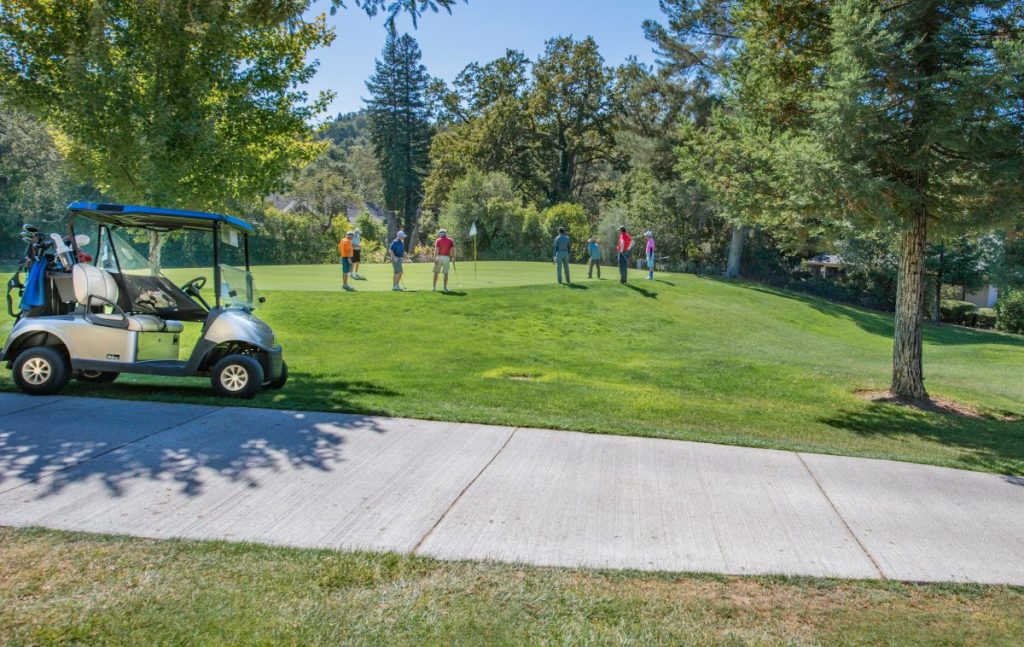In this blog post, we’re going to delve into the world of golf cart maintenance, specifically focusing on the brakes. Understanding the workings and potential deterioration of golf cart brakes is crucial for ensuring the safety and longevity of your cart. Just like any vehicle, the braking system of a golf cart is subject to wear and tear over time, impacting its performance and safety.
Whether you’re a casual golfer or operate a fleet of carts for commercial use, being aware of how your brakes work, the signs of wear, and how to maintain them can make a significant difference.
So, let’s dive in and discuss everything you need to know about golf cart brakes.
Understanding Golf Cart Brakes
To comprehend why golf cart brake deterioration matters, it’s essential to understand how these brakes work. Generally, golf cart brakes operate similarly to car brakes, employing a disc or drum mechanism to create friction against the wheel, slowing and eventually halting the cart.
However, golf carts often operate under unique conditions, like uneven terrain or lower speeds, which can influence the braking system’s wear and tear. Disc brakes, for instance, are more suited to high-speed, high-performance golf carts, while drum brakes are often adequate for more casual, low-speed use.
Understanding these mechanisms can help owners spot potential issues early and maintain their cart’s safety and performance. There are several types of golf cart brakes each suited to different circumstances.
Disc brakes, similar to those found in cars, are often used in high-performance, high-speed golf carts. They offer superior stopping power and are particularly useful in hilly conditions where more braking force may be required.
On the other hand, drum brakes are typically found in casual, low-speed golf carts. These brakes are simpler, more economical, and often last longer due to the lower stress they endure.
By understanding the type of brakes your golf cart has, you can better anticipate potential issues, maintain your cart effectively, and ensure a safe, smooth ride every time.
Signs of Golf Cart Brake Deterioration
Recognizing the signs of wear and tear on your golf cart brakes is a crucial aspect of maintaining your cart’s safety, performance, and longevity.
First and foremost, it’s important to be aware of any unusual noises when you apply the brakes. Sounds such as squeaking, grinding, or squealing, which may seem minor or insignificant at first, can often be indicative of your brakes starting to wear down. It’s important not to ignore these sounds as they can be the first warning signs of a potential issue.
Secondly, being attentive to how your golf cart feels when you apply the brakes can provide further insight into the condition of your brakes. If you begin to notice a decrease in your golf cart’s stopping power, or if the cart has a tendency to pull to one side when braking, these could be symptoms of brake deterioration. These changes can happen subtly over time, so it’s important to stay aware of any shifts in the handling of your golf cart.
In addition to these auditory and tactile signs, a visual inspection of the brakes can often be the most direct way to assess their condition. Regularly inspect the brakes for any signs of damage or excessive wear, such as worn-out brake pads or discolored brake discs. Visible signs of wear and tear are not to be taken lightly and should be addressed immediately to prevent further damage.
By staying vigilant to these signs, you can address any issues early on and keep your golf cart running smoothly and safely. It’s far easier, and often less expensive, to address these issues when they’re minor than to wait until they’ve become major problems.
If left unchecked, worn-out brakes can also put undue stress on other components of the golf cart, potentially leading to more significant mechanical problems down the line. This can escalate maintenance costs and decrease the lifespan of your golf cart.
Therefore, understanding and addressing brake deterioration promptly is crucial not only for the safety of the cart’s occupants but also for the overall performance and longevity of the golf cart. By keeping a close eye on your brakes and addressing any issues promptly, you can ensure that your golf cart remains safe and reliable, and continues to provide you with enjoyable rides for years to come.
Causes of Brake Deterioration
Normal wear and tear
One of the primary causes of golf cart brake deterioration is normal wear and tear. Just like any mechanical system, the components of your golf cart’s brakes gradually wear down over time due to regular use.
Each time you apply the brakes, the friction that’s needed to slow down your cart causes slight wear on the brake pads and discs. While this is a normal part of the operation, it does mean that these components will need to be replaced periodically to maintain optimal performance.
If the brake system is not monitored and maintained regularly, this natural wear and tear can lead to decreased brake performance, and ultimately, safety issues.
Lack of maintenance
Lack of maintenance is another significant cause of golf cart brake deterioration. Proper upkeep of your golf cart’s brakes is crucial to ensure their longevity and effectiveness. This includes regularly checking the brake fluid level, ensuring it’s at the recommended level, and replacing it as needed.
Brake pads and discs should also be inspected regularly for signs of excessive wear or damage and replaced promptly when necessary. Neglecting these maintenance tasks can lead to the premature wearing out of the brake system, decreased performance, and potential safety risks. Hence, consistent and thorough maintenance is the key to preventing brake deterioration and ensuring a safe, smooth ride on your golf cart.
Extreme conditions or usage
Another factor that can contribute to the deterioration of golf cart brakes is extreme conditions or usage. Golf carts that are used heavily, such as those frequently operated on hilly terrain or those used in commercial settings, may experience quicker brake wear and tear. Similarly, operating your golf cart in extreme weather conditions, like intense heat or cold, can also put additional stress on the brake system, leading to accelerated deterioration.
Being aware of how these conditions can affect your golf cart’s brakes will help you anticipate potential issues and take preventive measures, such as more frequent maintenance checks or earlier part replacements, to ensure your cart continues to operate safely and effectively.
Preventing Brake Deterioration
One of the most effective ways to prevent golf cart brake deterioration is through regular maintenance and checks. Just like any vehicle, your golf cart benefits immensely from consistent oversight and upkeep. This involves routinely inspecting the brake system for any signs of wear and tear or damage, ensuring the brake fluid is at the recommended level, and checking the brake pads and discs for any excessive wear. By conducting these checks, you can spot potential issues early before they escalate into more significant problems.
Regular maintenance not only extends the lifespan of your golf cart but also ensures it continues to provide safe and smooth rides.
Knowing when to replace brake parts is a critical aspect of maintaining your golf cart’s safety and performance. Brake pads and discs gradually wear down over time due to the friction needed to slow or stop your cart. If you notice decreased stopping power, hear unusual sounds when braking, or see visible signs of wear or damage during a brake inspection, these are strong indications that it’s time to replace these parts.
Regular replacement of worn brake parts not only helps to maintain the optimal performance of your golf cart but also prevents further damage to other components, saving you from potential costly repairs down the road.
A key aspect of maintaining your golf cart’s brakes is seeking professional servicing, especially when you’re unsure of the issues at hand. At South Florida Golf Carts, we offer expert service and maintenance checks for your golf cart’s brake system.
Our seasoned professionals are trained to spot and rectify any signs of deterioration early on, ensuring your cart remains safe and efficient. Beyond just replacing worn-out parts, our team can provide comprehensive servicing to keep your golf cart at peak performance. Leveraging professional services such as ours at South Florida Golf Carts is crucial in preventing serious brake issues and enhancing the longevity of your golf cart.
Understanding the deterioration of golf cart brakes is fundamental for maintaining the safety and longevity of your cart. Just like any other vehicle, the braking system of a golf cart is subject to wear and tear over time, and this can impact its performance and safety.
Whether you’re a casual golfer or operate a fleet of carts for commercial use, being aware of how your brakes work, the signs of wear, and how to maintain them can make a significant difference. It enables early detection of issues, timely repairs, and can prevent more costly damage down the line. So, keep an eye on those brakes, and ensure your cart continues to provide safe and enjoyable rides.
Taking care of your golf cart involves regular maintenance checks and immediate action once signs of brake deterioration are spotted. Here at South Florida Golf Carts, we offer professional servicing and maintenance checks to ensure your golf cart’s brake system remains in its best condition. Our trained professionals are skilled at identifying early signs of deterioration and are equipped to rectify them promptly, providing you with a golf cart that is not only efficient but safe.
So, don’t wait until it’s too late. Get in touch with us at South Florida Golf Carts today and let’s keep your golf cart performing at its best, guaranteeing you many more enjoyable rides.




